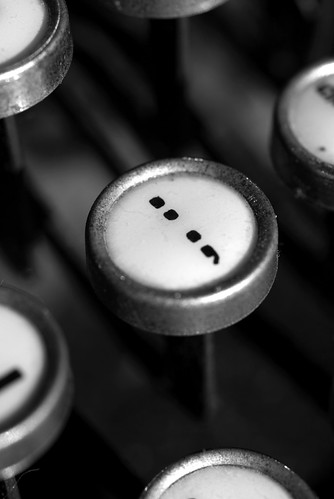My mom looked back at me and said, "Never, ever, say that in public."
 |
| Sorry, mom; I'm obviously still in my rebellious phase. |
I used to not like semi-colons, either; I never used them, I didn't know why I would need to use them, and I didn't understand why I had to capitalize the semi-colon to get the regular colon, even though the regular colons were obviously much more useful. Back then, I also used to use a ton of em-dashes.
An "em dash" is the technical name for a dash in the middle of a sentence. Used correctly, it's supposed to separate thoughts, so you can add something in quickly and move on with what you were saying, similar to a parenthesis (and we use em dashes all the time in speech, such as: "So then Jimmy - the kid who started the fight, remember - then he said....")
 Except, I wasn't using them correctly. I used em dashes when I wanted to start a new statement that related to my previous statement. Here are a few examples from my 2008 NaNoWriMo novel, Princess Kate:
Except, I wasn't using them correctly. I used em dashes when I wanted to start a new statement that related to my previous statement. Here are a few examples from my 2008 NaNoWriMo novel, Princess Kate:"They weren't my favorite ones – my favorite stuffed animal was a bean-bag tiger..."
"I never really liked the woman – I felt as if she was trying to..."
"'Of course not – that wouldn't be appropriate.'"
"'Let's go into the western wing – that's where the secrets are most likely kept.'"
These are just from the first few pages; there are plenty more. At the time, using dashes seemed like the obvious choice to me, but as I look back, I realize that every single one of these could - and should - be a semi-colon.
Later that school year, my English teacher taught us how to properly use semi-colons. It was a rigorous, week-long workout, forcing us to be comfortable with something we as a class had previously avoided. By the end of it, I made a realization: semi-colons did exactly what I was incorrectly forcing the em dash to do. I was trying to get a certain effect, but because I was ignorant as to how semi-colons worked, I didn't know how to get that effect properly.
The semi-colon, I discovered that year, is an amazing punctuation mark, and since then I've been stunned by the number of people who still don't know how to use it. It seems simple to me, and oh-so useful.
This is all a bit difficult to explain to someone who doesn't read a lot. As a kid, I used to read all the time, which is why writing comes so easy to me. I don't have to stop and think about the syntax or flow of the sentence; I can tell when something sounds bad, and what I need to do to make it sound better.
Most people, even if they like to read, can't do that (I can attest to this, because I was asked to edit many badly written stories in my English classes, written by students who liked to read but obviously weren't as experienced with the pen). I don't want to sound like an egotistical jerk, because I'm also really bad at explaining things like grammar and punctuation rules.
Instead of trying to teach you how to use the semi-colon properly, I'll point you in the direction of a humorous, well-written, explanatory visual, written and drawn by Matthew Inman of The Oatmeal. His chart is easy to follow, and should help anyone unfamiliar with the semi-colon learn its correct usages.
If you don't want to read the link just yet, or if you're already back and want a refresher, here's my explanation; a semi-colon is halfway between a period and a comma (that's why it's made up of the two). Semi-colons are used in all those places were a comma just isn't good enough, but a period is a bit too much.
If you want an example, go back up and re-read my whole blog; I've used 7 semi-colons so far (you can find them by going to your 'find' function - ctrl + f on windows - and typing in a semi-colon). Try re-reading those sentences, but replacing the semi-colon with either a comma or a period. See how the comma doesn't make sense? See how the period makes both sentences too short and choppy, especially right next to each other?
If you're wondering, yes, I did try specifically to use more semi-colons that normal. If I was avoiding the semi-colon, I could replace all those instances with some other punctuation or punctuation/conjunction combo. I didn't do that, because semi-colons flow better, in my mind. They're a kind on nonverbal 'because' or 'therefore'. They link two related statements together in a way that isn't awkward or wrong, and doesn't require either statement to change; it's like the semi-colon is saying "hey, I know you two want to be together, and I'm here to make it happen."
The semi-colon is my favorite punctuation mark, and I'm not afraid to say it. It has so many different functions, not the least of which is to make everything you say sound nicer and make more sense. It's almost as if the grammarians of the past made a list of all the punctuation marks they liked to use, and after they wrote down ten, they said "and for everything else, we'll use a semi-colon." I'll admit that I really abused it in today's post; don't worry, I'll tone it down in the future. However, I have used the semi-colon at least twice per post in the past, and I'll probably continue to use it just as often as I feel it needs to be used in future posts.
(Final semi-colon count: 9)




No comments:
Post a Comment